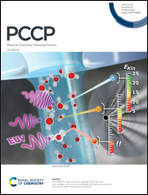Exchange-biased quantum tunnelling of magnetization in a [Mn3]2 dimer of single-molecule magnets with rare ferromagnetic inter-Mn3 coupling†
Abstract
A covalently-linked dimer of two single-molecule magnets (SMMs), [Mn6O(O2CMe)6(1,3-ppmd)3](ClO4)2, has been synthesized from the reaction of [Mn3O(O2CMe)6(py)3](ClO4) with 1,3-phenylene-bis(pyridin-2-ylmethanone) dioxime (1,3-ppmdH2). It contains two [MnIII3O]+7 triangular units linked by three 1,3-ppmd2− groups into an [Mn3]2 dimer with D3 symmetry. Solid-state dc and ac magnetic susceptibility measurements showed that each Mn3 subunit retains its properties as an SMM with an S = 6 ground state. Magnetization vs. dc field sweeps on a single crystal reveal hysteresis loops below 1.3 K exhibiting exchange-biased quantum tunnelling of magnetization (QTM) steps with a bias field of +0.06 T. This is the first example of a dimer of SMMs showing a positive exchange bias of the QTM steps in the hysteresis loops, and it has therefore been subjected to a detailed analysis. Simulation of the loops determines that each Mn3 unit is exchange-coupled with its neighbour primarily through the 1,3-ppmd2− linkers, confirming a weak ferromagnetic inter-Mn3 interaction of J12 ≈ +6.5 mK (Ĥ = −2JŜi·Ŝj convention). High-frequency EPR studies of a microcrystalline powder sample enable accurate determination of the zero-field splitting parameters of the uncoupled Mn3 SMMs, while also confirming the weak exchange interaction between the two SMMs within each [Mn3]2 dimer. The combined results emphasize the ability of designed covalent linkers to generate inter-SMM coupling of a particular sign and relative magnitude, and thus the ability of such linkers to modulate the quantum physics. As such, this work supports the feasibility of using designed covalent linkers to develop molecular oligomers of SMMs, or other magnetic molecules, as multi-qubit systems and/or other components of new quantum technologies.
![Graphical abstract: Exchange-biased quantum tunnelling of magnetization in a [Mn3]2 dimer of single-molecule magnets with rare ferromagnetic inter-Mn3 coupling](/en/Image/Get?imageInfo.ImageType=GA&imageInfo.ImageIdentifier.ManuscriptID=D0CP06611G&imageInfo.ImageIdentifier.Year=2021)


 Please wait while we load your content...
Please wait while we load your content...
